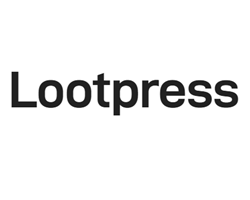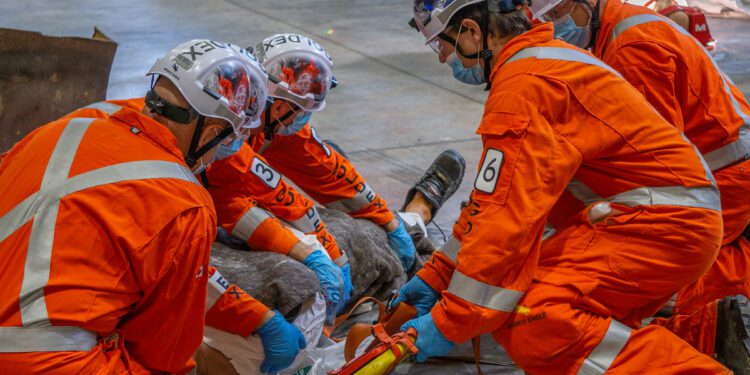WVSOM Assists MSHA with International Mines Rescue Competition

By Tyler Barker
September 22, 2022 - When miners from eight nations came together in Beaver, W.Va., to test their ability to respond to emergencies, the West Virginia School of Osteopathic Medicine (WVSOM) was there to help. The state’s largest medical school provided scenario design, staffing and state-of-the-art educational technology for the first aid portion of the event.
The International Mines Rescue Competition took placeSept. 11-16 at the National Mine Health and Safety Academy, operated by the U.S. Department of Labor’sMine Safety and Health Administration (MSHA).Hundreds of miners and other industry personnel attended the previously biennial competition, delayed since 2018 due to the COVID-19 pandemic.

For the event’s first aid competition, WVSOM exclusively partnered with MSHA to provide human-patient simulators — lifelike robotic devices that serve as stand-ins for livingpatients — and programmed them to mimic victims of an accident caused by a compressor blowing up, resulting in an electrical fire. As judges looked on, competitors in a warehouse-like building on the academy’s campus known as “Blue Falcon” raced to save lives.
The scenario was designed by Angie Amick, who coordinates the human-patient simulator program at WVSOM’s Clinical Evaluation Center; Abigail Frank, D.O., WVSOM’s assistant dean for graduate medical education; Janet Hinton, WVSOM’s director of rural outreach; and Mark Waddell, D.O., a WVSOM associate professor of clinical sciences. Waddell, who also served as an assistant to the first aid judges, said the scenario was created with real-world situations in mind.
“These are based on things miners across the world have experienced over the years,” Waddell said. “They’re a way to help people practice so that their skills are ingrained inboth their muscle memory and their cerebral memory, allowing them to give proper care and not panic when adrenaline takes over.”
Amick explained that the scenario required teams to assess the situation and determine the best course of action to quickly and effectively respond to four simulated patients.
“One victim had an injury to the left lower leg that causedan arterial bleed. Another sustained an electrical burn that entered through the hand and exited through the shoulder. One [portrayed by a human] was walking wounded and hada nail to the eye. The last was decapitated by a piece of flying metal,” Amick said. “Teams had to palpate pulses, correctly apply a tourniquet to stop the bleed, perform CPRand defibrillate a patient to get his heart rhythm back, and secure the foreign object in the eye of the walking patient and keep him from going into shock.”
Teams of seven members each were scored based on speed, hazard assessment, use of protective equipment, delegation of responsibilities and other factors in addition to the correct treatment of each patient. The use of human-patient simulators allowed judges to evaluate details that would otherwise be difficult to measure, such as the depth and rateof CPR compressions.
Despite the gruesomeness of the staged disaster — a scenario that required about two gallons of simulated blood per day — there was room for tenderness and empathy, too. Vernus Sturgill, an MSHA assistant district manager who served as a co-lead first aid judge, said it was fascinating to observe how teams from different cultures responded to the deceased “patient.”
“Some of the teams treated this person with such respect.They put his hard hat back on, they covered him up,” Sturgill said. “They were reassuring the simulators and talking to them as if they were live people. They had so much compassion and sympathy for their patients. It was amazing to see.”
Other events in the competition included firefighting, arope rescue and written theory assessments. Zambian copper miners, Canadian gold miners and workers from Australia, Colombia, Finland, India, Poland and the United States who travel underground in search of natural resources such as coal, diamond, magnesium and potash participated in the rescue-themed contests.
But Sturgill pointed out that the International Mines Rescue Competition isn’t just about winning. It’s also about education, he said.
“Training is one of the main reasons we host these simulations,” Sturgill said. “When we talked with teams afterward about what they did right and what they did wrong, a lot of them told us that they weren’t taught that way in their country or they didn’t have such advancedequipment. So this is a learning experience for them.”
Link Self, superintendent of the National Mine Health and Safety Academy, agreed, pointing out that WVSOM’s contribution of human-patient simulators was essential to the competition’s operation.
“We wanted the first aid competition to be as real as possible, and we were familiar with WVSOM’s simulation program,” Self said. “The school helped make it one of the most realistic competitions these teams have been to. It gave them a chance to hone their abilities and engage in friendly competition. It was fun to watch their expressions as they worked. When one of the mannequins’ eyes opened, it startled one of the team members so much that he jumped back. He wasn’t used to seeing a mannequin that can open its eyes, or bleed, or have a pulse.
That was the case for Danny Plante, a member of the Goldex Agnico Eagle Mine team, which traveled from Quebec, Canada, to participate in the competition.
“The mannequins made this very realistic,” Plante said. “They gave us the feeling that it was really happening, which gave us a sense of pressure, but it was a good pressure — the kind that helped us push the limits of our experience. The judges gave us excellent feedback. They said we did well overall, but they also showed us the problems we need to solve in order to get better.”
WVSOM’s Hinton said she was impressed by the teamwork and dedication the miners displayed. She also was pleased that the event allowed WVSOM to give back to MSHA after years of the two organizations collaborating to instruct students in the school’s Rural Health initiative, which gives aspiring rural physicians firsthand experience with some of West Virginia’s leading industries.
“It was an honor to be able to help MSHA with the competition, because they’ve helped us for many years,”Hinton said. “They’ve allowed us to set up simulations in the National Mine Health and Safety Academy’s lab to prepare students before we take them underground in actualcoal mines.”
Carol Richmond, an MSHA visual information specialist,said at least 600 people visited the National Mine Health and Safety Academy for the event, including competitors, translators, observers, MSHA’s own personnel and individuals from other organizations who helped stage the competition.
Waddell said events like this are an important way for miners to keep their rescue skills sharpened so that if a disaster occurs, casualties can be minimized.
“It was great to see people come together to use lots of different skills to make this a success, and to see teams from all over the world have a platform where we can learn from each other,” he said. “Miners have seen [accidents]happen to their friends, and they know it can happen to them. So they have a very real interest in being as competent as they can.”

